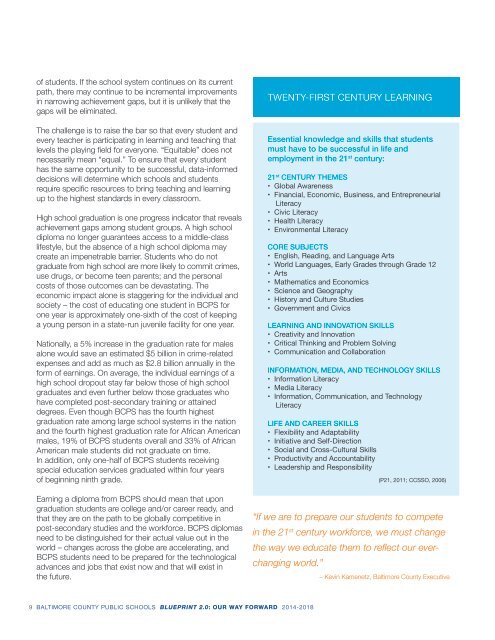BLUEPRINT 2.0 OUR WAY FORWARD
bcpsbrochure_final3
bcpsbrochure_final3
You also want an ePaper? Increase the reach of your titles
YUMPU automatically turns print PDFs into web optimized ePapers that Google loves.
of students. If the school system continues on its current<br />
path, there may continue to be incremental improvements<br />
in narrowing achievement gaps, but it is unlikely that the<br />
gaps will be eliminated.<br />
The challenge is to raise the bar so that every student and<br />
every teacher is participating in learning and teaching that<br />
levels the playing field for everyone. “Equitable” does not<br />
necessarily mean “equal.” To ensure that every student<br />
has the same opportunity to be successful, data-informed<br />
decisions will determine which schools and students<br />
require specific resources to bring teaching and learning<br />
up to the highest standards in every classroom.<br />
High school graduation is one progress indicator that reveals<br />
achievement gaps among student groups. A high school<br />
diploma no longer guarantees access to a middle-class<br />
lifestyle, but the absence of a high school diploma may<br />
create an impenetrable barrier. Students who do not<br />
graduate from high school are more likely to commit crimes,<br />
use drugs, or become teen parents; and the personal<br />
costs of those outcomes can be devastating. The<br />
economic impact alone is staggering for the individual and<br />
society – the cost of educating one student in BCPS for<br />
one year is approximately one-sixth of the cost of keeping<br />
a young person in a state-run juvenile facility for one year.<br />
Nationally, a 5% increase in the graduation rate for males<br />
alone would save an estimated $5 billion in crime-related<br />
expenses and add as much as $2.8 billion annually in the<br />
form of earnings. On average, the individual earnings of a<br />
high school dropout stay far below those of high school<br />
graduates and even further below those graduates who<br />
have completed post-secondary training or attained<br />
degrees. Even though BCPS has the fourth highest<br />
graduation rate among large school systems in the nation<br />
and the fourth highest graduation rate for African American<br />
males, 19% of BCPS students overall and 33% of African<br />
American male students did not graduate on time.<br />
In addition, only one-half of BCPS students receiving<br />
special education services graduated within four years<br />
of beginning ninth grade.<br />
Earning a diploma from BCPS should mean that upon<br />
graduation students are college and/or career ready, and<br />
that they are on the path to be globally competitive in<br />
post-secondary studies and the workforce. BCPS diplomas<br />
need to be distinguished for their actual value out in the<br />
world – changes across the globe are accelerating, and<br />
BCPS students need to be prepared for the technological<br />
advances and jobs that exist now and that will exist in<br />
the future.<br />
TWENTY-FIRST CENTURY LEARNING<br />
Essential knowledge and skills that students<br />
must have to be successful in life and<br />
employment in the 21 st century:<br />
21 st CENTURY THEMES<br />
• Global Awareness<br />
• Financial, Economic, Business, and Entrepreneurial<br />
Literacy<br />
• Civic Literacy<br />
• Health Literacy<br />
• Environmental Literacy<br />
CORE SUBJECTS<br />
• English, Reading, and Language Arts<br />
• World Languages, Early Grades through Grade 12<br />
• Arts<br />
• Mathematics and Economics<br />
• Science and Geography<br />
• History and Culture Studies<br />
• Government and Civics<br />
LEARNING AND INNOVATION SKILLS<br />
• Creativity and Innovation<br />
• Critical Thinking and Problem Solving<br />
• Communication and Collaboration<br />
INFORMATION, MEDIA, AND TECHNOLOGY SKILLS<br />
• Information Literacy<br />
• Media Literacy<br />
• Information, Communication, and Technology<br />
Literacy<br />
LIFE AND CAREER SKILLS<br />
• Flexibility and Adaptability<br />
• Initiative and Self-Direction<br />
• Social and Cross-Cultural Skills<br />
• Productivity and Accountability<br />
• Leadership and Responsibility<br />
(P21, 2011; CCSSO, 2006)<br />
“If we are to prepare our students to compete<br />
in the 21 st century workforce, we must change<br />
the way we educate them to reflect our everchanging<br />
world.”<br />
– Kevin Kamenetz, Baltimore County Executive<br />
9 BALTIMORE COUNTY PUBLIC SCHOOLS <strong>BLUEPRINT</strong> <strong>2.0</strong>: <strong>OUR</strong> <strong>WAY</strong> <strong>FORWARD</strong> 2014-2018


